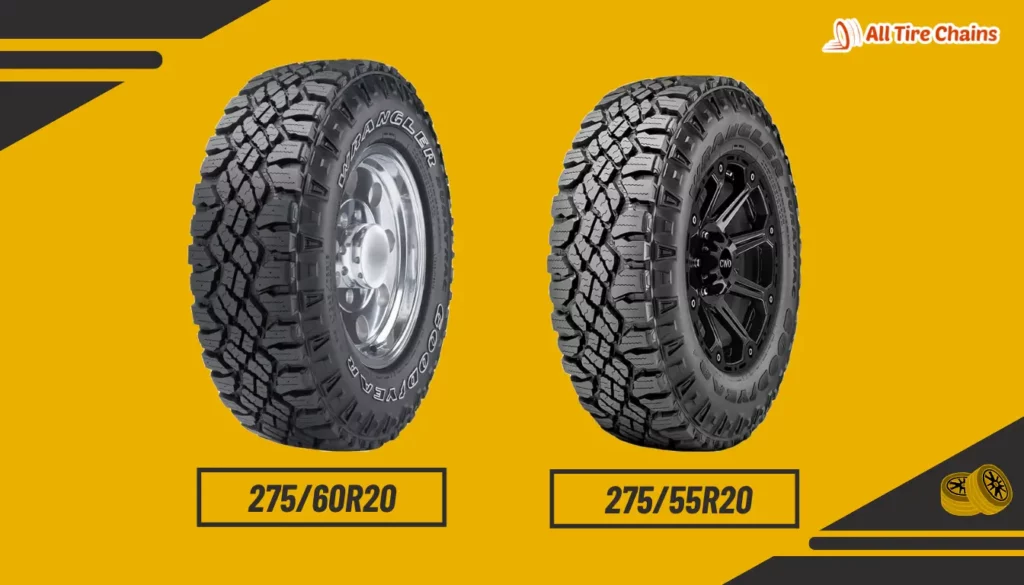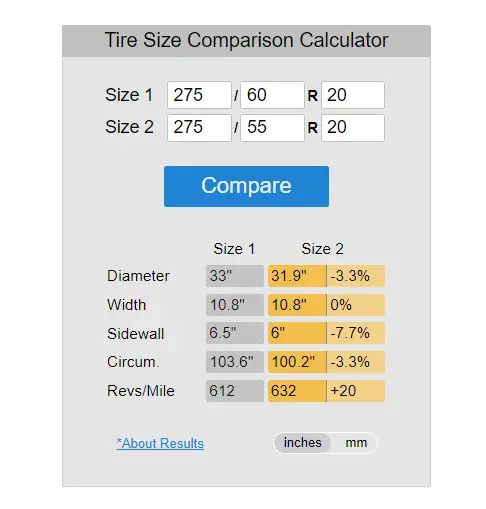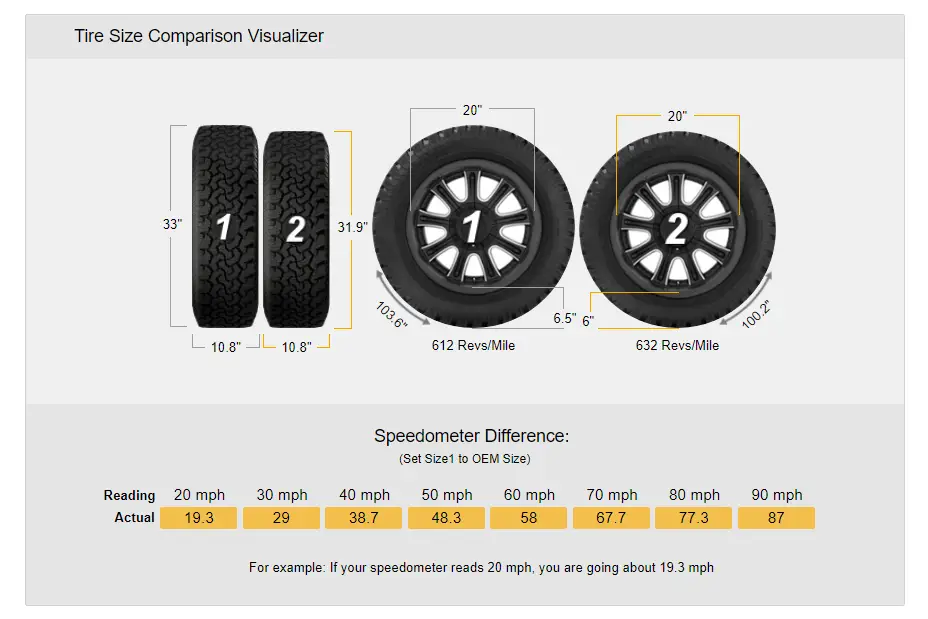Thinking of replacing your current 275/60R20 tires with 275/55R20 tires? Hold on! Before making the change, get the facts by reading this concise “Can I replace 275/60R20 with 275/55R20 tires?” guide. We’ll cover compatibility, sizing, rims, and more.
As a car enthusiast, I know how important it is to maintain and upgrade our vehicles. Recently, I found myself pondering whether I could replace my current 275/60R20 tires with 275/55R20 tires. I wanted to explore the possibilities and understand the implications of changing tire sizes. It’s a decision that requires careful consideration, as altering tire sizes can have a significant impact on a vehicle’s performance and safety.

Like me, you may be curious to know if you can replace your tires with a different size. Will the new tires offer the same level of performance and safety? What factors should you consider before making the switch?
In this comprehensive guide, we will delve into the world of changing tire sizes and explore the compatibility of replacing 275/60R20 tires with 275/55R20 tires. So without further ado, let’s navigate through the dimensions, terminologies, and industry insights to help you make an informed decision.
Key Takeaways:
- Replacing 275/60R20 tires with 275/55R20 tires is possible but requires careful consideration.
- A tire size calculator can help determine compatibility and differences between tire sizes.
- Consulting with a qualified tire specialist or technician is crucial to ensure safety and compliance with standards.
- Changing tire sizes can affect speedometer accuracy, ride comfort, load capacity, and vehicle handling.
- Considering the pros and cons of switching tire sizes is essential for making an informed decision.
What Do the Numbers and Letters on Tires Mean?
When it comes to tires, you may have noticed a combination of numbers and letters imprinted on the sidewall. But have you ever wondered what these codes actually mean? Well, you’re not alone. The numbers and letters on tires are actually an important part of understanding the size and specifications of a tire.
Tire size terminology can be confusing for many people. Understanding the different components and measurements can help in determining the compatibility of different tire sizes. For an example, let’s take a look at the numbers and letters on the sidewall of 275/60r20 tires.
- The first number in a tire size, such as 275 in 275/60R20, represents the width of the tire in millimeters. In this case, the tire width is 275 millimeters.
- The second number, such as 60 in 275/60R20, indicates the aspect ratio. It represents the ratio of the tire’s height to its width. In this case, the height of the tire is 60% of its width.
- The letter R denotes the tire’s construction type, which in this case is radial.
- The final number, such as 20 in 275/60R20, represents the diameter of the wheel in inches. In this case, the wheel diameter is 20 inches.

Comparing the dimensions of 275/60R20 and 275/55R20 tires can help understand the differences between the two sizes and their potential impact on vehicle performance.
You might also like: Do You Need an Alignment After Replacing Tires? – The Expert’s Guide
Comparing 275/60R20 and 275/55R20 Tire Dimensions
What are the differences between 275/60R20 and 275/55R20 tires? Well, as we mentioned earlier, the aspect ratio is what sets them apart. The tire with an aspect ratio of 60 will provide a more comfortable ride due to the taller sidewall and increased flex. On the other hand, the tire with an aspect ratio of 55 will offer a sportier feel and improved handling capabilities.
To compare the dimensions of two tire sizes, let’s take a closer look at the measurements of 275/60R20 and 275/55R20 tires.
In the case of 275/60R20 tires, the width is 275 millimeters, the aspect ratio is 60, and the wheel diameter is 20 inches. This means the tire’s height is 60% of its width, resulting in a tire height of 165 millimeters (6.5 inches).
On the other hand, 275/55R20 tires have the same width of 275 millimeters but a slightly lower aspect ratio of 55. The wheel diameter remains at 20 inches. With an aspect ratio of 55, the tire height is 55% of its width, resulting in a tire height of 151.25 millimeters (5.96 inches).
| Tire Size | Width | Aspect Ratio | Wheel Diameter | Tire Height |
|---|---|---|---|---|
| 275/60R20 | 275mm | 60 | 20 inches | 165mm (6.5 inches) |
| 275/55R20 | 275mm | 55 | 20 inches | 151.25mm (5.96 inches) |
It’s important to note that changing the tire size from 275/60R20 to 275/55R20 will result in a slightly lower tire height of 0.54 inches. This can have implications on various aspects of the vehicle’s performance and safety.
To further illustrate the differences between 275/55R20 vs 275/60R20 tires, watch this engaging video by Custom Offsets titled “275/55 Nitto 420 S on a 20×10 -18 XD 834 Cyclone”.
Great! Now that you understand the key differences between 275/60R20 and 275/55R20 tires, let’s see if switching to the latter is feasible for your vehicle.
Must check: Can You Put 35 Inch Tires on 20 Inch Rims? A Comprehensive Guide
Can I Replace 275/60R20 with 275/55R20 Tires?
Yes, you can replace 275/60R20 tires with 275/55R20 tires on most vehicles, but compatibility depends on your specific car model and rim size. While both tires have the same width (275), the 275/55R20 has a smaller sidewall height (55% of width) compared to the 275/60R20 (60% of width).
This results in a 1-inch diameter reduction, affecting speedometer accuracy, ride height, and handling dynamics. However, the difference is small enough that it shouldn’t be a safety concern.
It is important to consult your vehicle’s owner’s manual or a qualified tire professional to ensure that the 275/55R20 tires are compatible with your vehicle and its weight capacity. Some vehicles may have clearance issues with larger tires, or the weight capacity of the vehicle may not be sufficient for the heavier tires.

When considering replacing your current 275/60R20 tires with 275/55R20 tires, there are several factors that you need to take into account. These factors include the diameter and speedometer accuracy, sidewall height and ride comfort, as well as the load capacity and vehicle performance.
Here are some of the important factors to keep in mind when considering replacing your tires:
Factor #1: Diameter and Speedometer Accuracy
Changing the tire size can affect the overall diameter of the tire, which in turn can impact the accuracy of your speedometer. With 275/55R20 tires being smaller in diameter compared to 275/60R20 tires, your speedometer may display a slightly lower speed than your actual speed.
Factor #2: Sidewall Height and Ride Comfort
The sidewall height of a tire plays a role in the overall ride comfort. Switching from 275/60R20 to 275/55R20 tires will result in a lower sidewall height, potentially leading to a slightly stiffer ride compared to your current tires.
Factor #3: Load Capacity and Vehicle Performance
Different tire sizes may have varying load capacities, which can affect the overall performance of your vehicle. It’s essential to check the load rating of the new tire size to ensure it can handle the weight of your vehicle and its occupants.
Consulting with a tire specialist or technician can provide you with more specific information on the compatibility and safety of replacing your 275/60R20 tires with 275/55R20 tires.
You might also like: What to Do After Getting New Tires Installed: The Ultimate Checklist
Impact of Swapping Tire Sizes on Vehicle Handling
Swapping tire sizes can have a significant impact on the handling dynamics and suspension of your vehicle. Before making any changes, it’s important to understand how different tire sizes can affect your car’s performance and safety.
Handling Dynamics
Changing to a different tire size, such as replacing 275/60R20 with 275/55R20, can alter the handling characteristics of your vehicle. The dimensions and properties of the tires play a critical role in how your car responds to steering inputs and corners. With a different tire size, you may experience changes in responsiveness, stability, and overall control.
Potential Impact on Suspension
Altering the tire size can also have an impact on your vehicle’s suspension system. The change in tire dimensions can affect the load distribution, ride comfort, and overall performance of the suspension components.
The suspension may need to compensate for the new tire size, which can lead to changes in the way the car absorbs bumps, maintains stability, and delivers a comfortable ride.

To ensure that any tire size changes are suitable for your specific vehicle and its suspension setup, consult with a tire specialist or technician. They can provide expert advice and guidance based on the make and model of your car, helping you understand the potential impact on handling and suspension performance.
You might also like: Are Snow Tires Good in Mud? Unveiling the Truth
Use Tire Size Calculator to Get Exact Measurements
A tire size calculator is a must-have for anyone looking to swap tire sizes while ensuring vehicle performance isn’t compromised. These online tools (Tire size calculator and Tire size comparison calculator) offer a quick way to compare tire dimensions, giving insights into speedometer accuracy, sidewall height, and more.
Simply input your current and desired tire sizes in the tire size calculator, say from 275/60R20 to 275/55R20, and voilà, you get precise comparisons on width, aspect ratio, diameter, circumference, and revolutions per mile.

Using these calculators is a breeze. Enter the existing and new tire sizes, and instantly, you’ll see a comprehensive comparison. This data is crucial for understanding how a tire size change affects your vehicle’s performance, safety, and fuel efficiency.

However, don’t make these decisions in isolation. Consulting a tire expert is key. They can offer tailored advice on tire size compatibility, ensuring your choices are both safe and suitable for your vehicle.
In short, with a tire size calculator and expert advice, you’re well-equipped to make informed tire size changes. This approach guarantees that all critical factors are considered, paving the way for a confident and informed decision.
Must check: How to Clean White Wall Tires That are Yellow (5 Quick Steps)
The Role of Aspect Ratio in Tire Sizes: 60 vs 55
The aspect ratio of a tire is an important factor that affects its overall dimensions and performance. Understanding the aspect ratio can help vehicle owners make informed decisions when choosing a tire size.
What is Aspect Ratio?
The aspect ratio represents the ratio of the tire’s height to its width. In the case of tire sizes like 275/60R20 and 275/55R20, the aspect ratio is expressed as a percentage. For example, in 275/60R20 tires, the aspect ratio is 60, meaning the height of the tire is 60% of its width.
Similarly, in 275/55R20 tires, the aspect ratio is 55, resulting in a slightly lower tire height compared to the 275/60R20 tires. This ratio plays a crucial role in determining the overall dimensions and characteristics of the tire.
Performance Implications of Changing Aspect Ratio
Changing aspect ratio, such as upgrading from 275/60R20 to 275/55R20 tires, can have certain performance implications.
One of the performance factors affected by changing aspect ratio is gas mileage. A lower aspect ratio, as found in 275/55R20 tires, can result in a slight reduction in gas mileage compared to the original 275/60R20 size.
Additionally, although the width of the tire, which remains at 275 millimeters in both sizes, is not directly affected by the change in aspect ratio, it is important to note that switching to 275/55R20 tires will not provide a wider tire compared to 275/60R20 tires.
When considering upgrading or changing tire sizes, it’s crucial to consider the potential implications of aspect ratio on performance, such as gas mileage and tire dimensions.
Before deciding on the impact of changing tire size from 275/60R20 to 275/55R20, check out this insightful video by JB Reviews, “295/60/20 VS 295/65/20 All Terrain Tire.”
Must check: How Long Can You Drive on Tires with Wire Showing? The Risk Revealed
Will My Insurance Be Affected By Changing Tire Size from 275/60R20 to 275/55R20?
Yes, changing tire size from 275/60R20 to 275/55R20 may affect your insurance rates if the new tires alter your vehicle’s performance characteristics. Insurers consider factors like speed rating, load index, and overall diameter. It’s best to contact your provider to see if the swap will impact your policy or premiums. They can review specifics and advise you accordingly.
Consulting with your insurance provider about the tire size change will help you understand if they have any specific guidelines or policies regarding modifications. While it is unlikely to result in increased insurance costs, informing your provider can help avoid any potential issues related to non-disclosure of modifications.
Safeguard yourself by maintaining open and transparent communication with your insurance provider. By doing so, you can ensure that the changes you make to your vehicle, such as switching to 275/55R20 tires, comply with their guidelines and do not impact your coverage.
Remember, each insurance provider may have their own criteria and policies, so it is best to consult with them directly to address any specific concerns you may have regarding tire size changes and insurance coverage.
Tire Size Differences and Fuel Efficiency
When considering changing tire size, it is important to understand the impact it can have on fuel efficiency. One of the key factors affected by tire size is the rolling circumference of the tire, which directly influences fuel consumption.
With regards to the comparison between 275/60R20 and 275/55R20 tires, the smaller size of 275/55R20 will result in a different number of revolutions per mile compared to the larger 275/60R20. This difference in revolutions per mile can potentially affect fuel efficiency, as the vehicle’s engine will need to work differently to accommodate the altered tire size.
Furthermore, the change in tire size can also impact the accuracy of the odometer. A smaller tire size, such as 275/55R20, means that each revolution of the tire covers a shorter distance compared to a larger tire size like 275/60R20. As a result, the odometer may not accurately reflect the actual distance traveled.

To assess the potential impact on fuel efficiency before making any changes to tire size, it is advisable to consult with a tire specialist or technician. They can provide expert advice and guidance based on the specific vehicle and driving requirements, helping vehicle owners make informed decisions.
You might also like: Why are My Tires Turning Brown on the Sides?
Pros and Cons of Switching from 275/60R20 to 275/55R20 Tires
Can I replace 275/60R20 with 275/55R20 tires? Yes, but let’s weigh the pros and cons. Discover how this swap impacts your vehicle’s handling and fuel efficiency. Learn about the potential changes in ride comfort and speedometer accuracy. Equip yourself with the knowledge to decide if this tire size adjustment is right for you.
Advantages of Replacing 275/60R20 with 275/55R20 Tires
- Improved Handling and Responsiveness: Smaller tire sizes like 275/55R20 can provide better handling and responsiveness, allowing for more precise control and maneuverability on the road.
- Increased Stability: With a lower sidewall height, 275/55R20 tires offer increased stability, especially during high-speed driving or cornering.
- Wider Range of Tire Options: Choosing a popular tire size like 275/55R20 gives you a broader selection of tire brands, models, and performance characteristics to choose from, providing more flexibility in meeting your specific driving needs.
- Potentially improved fuel efficiency: Smaller tires can sometimes lead to slightly improved fuel efficiency due to reduced rolling resistance. However, this is not always the case and depends on various factors.
- Enhanced appearance: Depending on your aesthetic preferences, a lower profile tire can create a sportier look for your vehicle.
Disadvantages of Replacing 275/60R20 with 275/55R20 Tires
- Slightly Harsher Ride: Downsizing to 275/55R20 tires can result in a slightly harsher ride due to the lower sidewall height. The reduced flexibility of the sidewall may transmit more vibrations and road imperfections to the cabin.
- Potential Impacts on Load Capacity and Towing Capabilities: Changing tire sizes can affect load capacity and towing capabilities. It’s essential to ensure that the load rating of the new tire size matches or exceeds the requirements of your vehicle.
- Compromises in Overall Comfort and Performance: While downsizing tires may offer advantages in certain areas, it can also lead to compromises in overall comfort and performance. It’s important to consider how these trade-offs may affect your specific driving preferences and requirements.
- Reduced ground clearance: Downsizing tires can result in reduced ground clearance, which may be a concern if you frequently drive on uneven terrain or off-road.
- Increased susceptibility to damage: The lower sidewall profile of 275/55R20 tires makes them more susceptible to damage from potholes and other road hazards.
- Potential speedometer and odometer inaccuracies: Changing tire sizes can affect the accuracy of your vehicle’s speedometer and odometer readings. It’s important to have these recalibrated if necessary.
| Advantages | Disadvantages |
|---|---|
| Improved handling and responsiveness on the road. | Slightly harsher ride due to lower sidewall height. |
| Increased stability during high-speed driving and cornering. | Potential impacts on load capacity and towing capabilities. |
| Broader selection of tire brands, models, and performance characteristics. | Compromises in overall comfort and performance. |
| Potentially improved fuel efficiency due to reduced rolling resistance. | Reduced ground clearance, affecting uneven terrain or off-road driving. |
| Enhanced vehicle appearance with a sportier, lower profile look. | Increased susceptibility to damage from potholes and road hazards. |
| Potential inaccuracies in speedometer and odometer readings. |
Consulting with a tire specialist or technician can provide personalized guidance based on your vehicle’s specific needs, helping you make an informed decision about switching from 275/60R20 to 275/55R20 tires.
Must check: How Long Do Mercedes Tires Last? (Not as Long as You Think!)
Finding a Tire Specialist for Advice on Changing Tire Size
When considering changing tire size, it’s essential to consult with a qualified tire specialist or technician who can provide expert advice and guidance.
Locating a Qualified Technician
To find a tire specialist, you can start by contacting local tire shops or dealerships and asking if they have technicians experienced in tire sizing. Online directories and customer reviews can also help identify reputable tire specialists.
Questions to Ask Your Tire Specialist
When speaking with a tire specialist, consider asking questions such as:
- Will 275/55r20 tires fit on my 275/60r20 rims?
- What are the potential impacts on vehicle performance and safety when substituting 275/55r20 for 275/60r20?
- Are any modifications or adjustments necessary when changing tire sizes?
A tire specialist can provide personalized advice based on the specific vehicle and requirements, ensuring that the chosen tire size is compatible and meets safety standards.
Cost Comparison of 275/60R20 vs 275/55R20 Tires
When considering the swap from 275/60R20 to 275/55R20 tires, the financial implications are multifaceted. Initially, the 275/55R20 tires come out as the more budget-friendly option, saving you approximately $20 per tire. This upfront cost advantage is appealing for those looking to cut immediate expenses.
Moreover, these smaller tires promise slightly better fuel efficiency, potentially improving by about 1 mpg. However, the real-world impact on fuel savings is modest. For instance, driving 15,000 miles annually at $3.50 per gallon translates to a mere $85 saving per year on fuel.
Therefore, while the initial purchase and fuel efficiency present opportunities for savings, the overall financial benefit is somewhat balanced. The gains in upfront tire costs and marginal fuel savings are counterbalanced by the minimal difference in long-term fuel expenditure.
Cost Comparison Table: Switching Tire Size from 275/60R20 to 275/55R20
| Factor | 275/60R20 | 275/55R20 | Difference |
|---|---|---|---|
| Tire Price (each) | $200-$300 | $180-$280 | -$20 |
| Fuel Efficiency (potential improvement) | – | +1 mpg | Slight |
| Installation | $50-$80 | $50-$80 | None |
| Warranty Impact | Varies | Varies | – |
| Alignment Adjustment | $50-$100 | $50-$100 | None |
| Annual Fuel Cost Savings | – | -$85 | – |
In essence, the decision to downsize tires is not just about immediate cost savings but also involves considering long-term financial impacts, which may not be as significant as one might hope.
Final Thoughts on Replacing 275/60R20 with 275/55R20 Tires
In simple words, Yes, it is possible to replace 275/60R20 tires with 275/55R20 tires. However, before making the change, it is important to consider several factors to ensure a safe and suitable replacement.
Key factors to evaluate include diameter and speedometer accuracy, sidewall height, load capacity, vehicle handling, and fuel efficiency. These factors can have implications on the overall performance and safety of the vehicle.
Consulting with a tire specialist or technician is highly recommended. They can provide personalized advice and expert guidance to ensure that the selected tire size is compatible with the specific vehicle and meets safety standards.
By considering these factors and seeking professional advice, vehicle owners can make an informed decision about replacing their tire sizes, ensuring optimal performance and safety on the road.
You might want to explore:
- Will Les Schwab Mount Tires Bought Elsewhere? Understanding Policy
- Top 10 Best Snow Chains for 35 Inch Tires to Conquer Winter Roads
- Do New Tires Come With Rims in Them? Know Before You Buy
- How to Get Skunk Smell Off Car Tires Fast: Banish the Stink in Minutes!
- Are Snow Tires Good in the Rain for Driving? In-Depth Analysis

